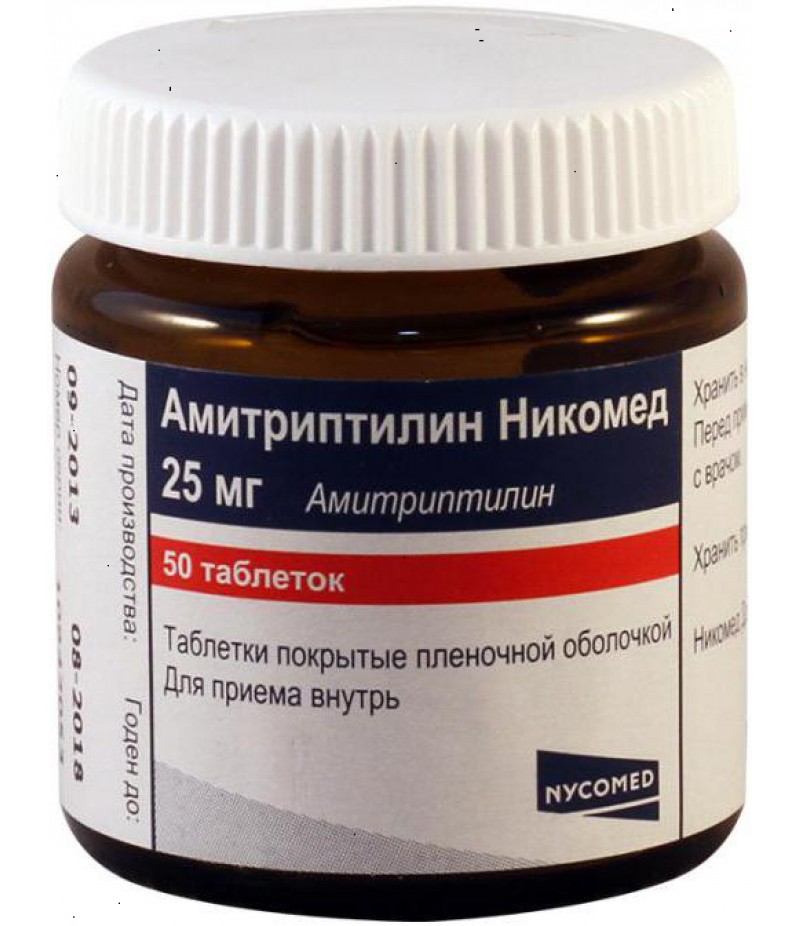Amitriptyline 25mg #50
- $3.30
- 3 or more $2.99
- Availability:Out Of Stock
Amitriptyline instructionYou can buy Amitriptyline on this pageDosage form: coated tablets.The form of release: round biconcave tablets of yellow color, covered with a film membrane.Clinico-pharmacological group: drugs that have t..
Tags: tabs
Amitriptyline instruction
You can buy Amitriptyline on this page
Dosage form: coated tablets.
The form of release: round biconcave tablets of yellow color, covered with a film membrane.
Clinico-pharmacological group: drugs that have thymolytic, antioxiotic, sedative and antidepressant effects on the nervous system.
Pharmacotherapeutic group: Psychoanaleptics. Antidepressants. Non-selective blockers of reverse neuronal capture of biogenic amines containing one amine group.
Composition
Active ingredient: Amitriptyline hydrochloride
Excipients:
single-crystal cellulose;
lactose monohydrate;
hypromellose;
colloidal anhydrous silicon dioxide;
E171 (titanium dioxide);
polysorbate 80;
talc;
sodium croscarmellose;
magnesium stearate;
polyethylene glycol 6000;
E122 (carmozine).
Packaging
Tablets in a blister (10 pieces each), cardboard box.
Pharmacodynamics
The mechanism of antidepressant action of the drug is based on the inhibition of reverse neuronal seizure of dopamine, norepinephrine and serotonin. It is an antagonist of muscarinic cholinergic receptors, has antiadrenergic and antihistaminic properties, is effective in bedwetting. Has a central analgesic effect, anti-bulimic and antiulcer action. For full manifestation of antidepressant action, it takes 2-4 weeks.
Pharmacokinetics
Bioavailability of Amitriptyline when administered parenterally is 30-60%, the bioavailability of nortriptyline, which is its active metabolite - 46-70%. To achieve the maximum concentration in the blood, it takes 2-7.5 hours from the beginning of the intake.
C max in blood plasma - 0.04-0.16 μg / ml. The drug has the ability to pass through the histohematological barriers, including the blood-brain barrier. In tissues accumulates in a greater concentration than in the blood. The connection with plasma proteins is 92-96%.
The drug disintegrates in the liver with the formation of active and inactive metabolites. Half-life from blood plasma: for Amitriptyline - 10-28 hours, for nortriptyline - 16-80 hours. 80% of the drug is excreted by the kidneys, partially excreted together with the bile for several days. It is able to penetrate the placental barrier, in breast milk is found in the same amounts as in plasma.
Indications for use
Schizophrenia;
Anxious-depressive conditions;
Unspecified organic psychosis (involutionary, neurotic, endogenous, reactive brain damage);
Bulimia nervosa;
Behavioral disorders;
Medication psychosis;
Prevention of migraine;
Inorganic enuresis;
Chronic pain syndrome of a neurogenic nature;
Mixed emotional disorders.
Side effects
Dry mouth, taste, nausea, vomiting, diarrhea, constipation and other disorders of the digestive tract. Skin allergic reactions, dizziness, weakness, sleep disorders. Delayed urination, increased sweating, movement disorders. Symptoms of heart failure, visual disturbances, increased intraocular pressure, paresis of the ciliary muscle of the eye. Changing the composition of the blood, a violation of potency, a change in libido, bowel obstruction. With prolonged use of the drug, weight gain, increase in the size of the mammary glands (in women and men), hair loss and enlarged lymph nodes.
Contraindications
Hypersensitivity to the components of the drug;
Myocardial infarction (acute phase and rehabilitation period);
Use in the 2 weeks preceding treatment, antidepressants (MAO inhibitors);
Arterial hypertension;
BPH;
Pylorostenosis;
Heart failure (decompensation stage);
Blockade of the heart (violation of intracardiac conduction);
Atony of the bladder;
Intestinal obstruction;
Children under 6 years;
Pregnancy and lactation;
Renal and hepatic insufficiency.
Interaction with other medicinal products
Amitriptyline is incompatible with antidepressants (MAO inhibitors). Strengthens the depressing effect on the central nervous system while using with anticonvulsant drugs, hypnotics, anesthesia and analgesics. When interacting with anticholinergic drugs and neuroleptics, an increase in body temperature, the development of intestinal obstruction, is possible. Simultaneous use with catecholamines and other adrenostimulators can cause heart rhythm disturbances and the development of severe arterial hypertension. It is able to reduce the effect of sympatholytic and vasoconstrictive drugs. Simultaneous use of Amitriptyline and cimetidine, due to an increase in the concentration of antidepressant in the blood plasma, leads to the development of toxic effects, barbiturates and carbamazepine reduce its concentration. Oral estrogen-containing contraceptives increase the bioavailability of the drug, quinidine slows its metabolism. When combined with acetal dehydrogenase inhibitors, delirium may develop (a mental disorder that proceeds with a violation of consciousness). Interaction with Probucol strengthens cardiac arrhythmia. Against the background of taking Amitriptyline may increase the depression, provoked by glucocorticoid drugs. Joint use with drugs used in the treatment of thyrotoxicosis, increases the risk of agranulocytosis. With great caution, use the drug with Baclofen and Digitalis.
Dosing and Administration
The initial dose for adults is 25-50 mg;
The average daily initial dose for adults: 150-250 mg, divided into 2-3 doses. Within 5-6 days the dose is gradually increased;
For treatment in outpatient settings, the maximum dose is 150 mg / day;
For treatment under stationary conditions, the maximum dose is up to 300 mg / day;
For elderly patients - up to 100 mg / day;
In the treatment of chronic headaches of a neurogenic nature - 12.5-25 mg / day;
For children older than 6 years (with treatment of enuresis) - 12.5-25 mg / day (no more than 2.5 mg mg per 1 kg of body weight).
Overdose
With an overdose of Amitriptyline, there is an increase in body temperature, a violation of cardiac conduction, ventricular arrhythmia, extrasystole, hallucinations, delirium, convulsions, coma.
Storage conditions
Store in a dark place, protected from light and moisture, inaccessible to children, at a temperature not exceeding 25 ° C.
Shelf life
The drug is suitable for use for 4 years from the date of release. Do not use the product beyond the expiry date printed on the package.

